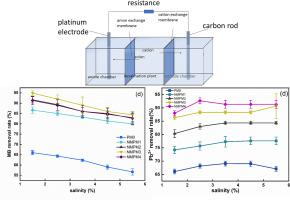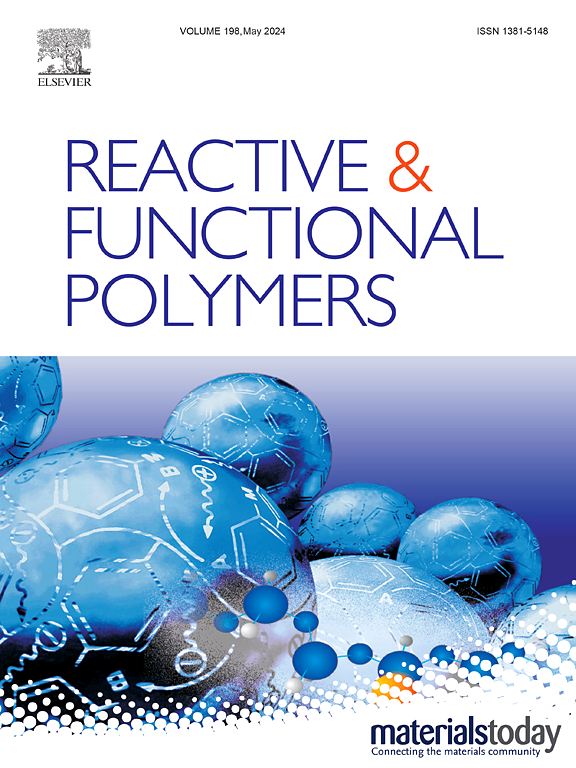Preparation and performance study of N-LAC/MoS2/PVDF ion exchange membrane in microbial desalination cells
IF 4.5
3区 工程技术
Q1 CHEMISTRY, APPLIED
引用次数: 0
Abstract
Ion exchange membranes play a crucial role in the study of microbial desalination cells (MDC). This study introduces a novel N-LAC/MoS2/PVDF ion exchange membrane prepared via chemical grafting, emphasizing its role in enhancing MDC efficiency. The research thoroughly assesses the membrane's microstructure, infrared spectroscopy, and water flux, revealing how the composite additives enhance hydrophilicity, alter contact angles, and improve pore structure. The incorporation of hydrophilic groups like hydroxyl, carboxyl, and carbonyl groups into the membrane significantly improves its hydrophilicity. The optimal performance is achieved with 1 wt% N-LAC/MoS2, increasing porosity to 86.94 % (a 25.5 % increase from pure PVDF) and reducing the contact angle to 71.59° (a 14.12 % decrease from pure PVDF). It also achieves an 84.1 % desalination efficiency under set conditions. The membrane shows high removal efficiency for methylene blue (MB) and Pb2+, reaching up to 93–96 % for MB and 91–94 % for Pb2+ under different pH, concentration, temperature, and salinity conditions. Its reusability is also notably enhanced. This work presents a tailored composite material for MDCs, offering insights into its interaction mechanisms and performance contributions to the MDC system, marking a significant advancement in membrane-based desalination technology.

微生物脱盐电池中 N-LAC/MoS2/PVDF 离子交换膜的制备和性能研究
离子交换膜在微生物脱盐电池(MDC)的研究中发挥着至关重要的作用。本研究介绍了一种通过化学接枝法制备的新型 N-LAC/MoS2/PVDF 离子交换膜,强调其在提高 MDC 效率方面的作用。研究全面评估了膜的微观结构、红外光谱和水通量,揭示了复合添加剂如何增强亲水性、改变接触角和改善孔隙结构。在膜中加入羟基、羧基和羰基等亲水基团可显著提高膜的亲水性。1 wt% 的 N-LAC/MoS2 可实现最佳性能,将孔隙率提高到 86.94%(与纯 PVDF 相比提高了 25.5%),并将接触角减小到 71.59°(与纯 PVDF 相比减小了 14.12%)。在设定条件下,它的脱盐效率也达到了 84.1%。在不同的 pH 值、浓度、温度和盐度条件下,该膜对亚甲蓝(MB)和 Pb2+ 的去除率很高,对 MB 的去除率高达 93-96%,对 Pb2+ 的去除率高达 91-94%。其重复利用率也显著提高。这项研究提出了一种为 MDC 量身定制的复合材料,深入探讨了它与 MDC 系统的相互作用机制和性能贡献,标志着膜法海水淡化技术的重大进步。
本文章由计算机程序翻译,如有差异,请以英文原文为准。
求助全文
约1分钟内获得全文
求助全文
来源期刊

Reactive & Functional Polymers
工程技术-高分子科学
CiteScore
8.90
自引率
5.90%
发文量
259
审稿时长
27 days
期刊介绍:
Reactive & Functional Polymers provides a forum to disseminate original ideas, concepts and developments in the science and technology of polymers with functional groups, which impart specific chemical reactivity or physical, chemical, structural, biological, and pharmacological functionality. The scope covers organic polymers, acting for instance as reagents, catalysts, templates, ion-exchangers, selective sorbents, chelating or antimicrobial agents, drug carriers, sensors, membranes, and hydrogels. This also includes reactive cross-linkable prepolymers and high-performance thermosetting polymers, natural or degradable polymers, conducting polymers, and porous polymers.
Original research articles must contain thorough molecular and material characterization data on synthesis of the above polymers in combination with their applications. Applications include but are not limited to catalysis, water or effluent treatment, separations and recovery, electronics and information storage, energy conversion, encapsulation, or adhesion.
 求助内容:
求助内容: 应助结果提醒方式:
应助结果提醒方式:


